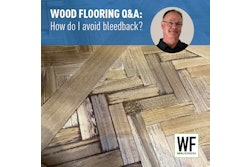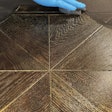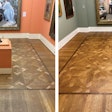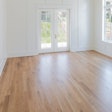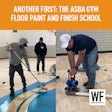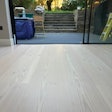The Problem
Jack's recently finished, white-stained floor has begun to peel in some spots. The floor was beautiful, the customer was delighted and Jack feels that he did everything right. He didn't sand too smoothly, he used a stain, sealer and topcoat from the same manufacturer, he allowed two days' dry time on his stain, and he even hand-sanded the first two coats of waterborne sealer and finish.
The Procedure
After detailed questioning, we learned Jack's procedure. He did a lot of things right, but also did a few important things wrong. It was springtime,raining and the heat was not on in the house. The floor was drum-sanded and edged with 100-grit sandpaper, and the edges were hand-sanded. Cracks were filled with a waterborne crack filler. Since the customer chose a pastel color and the floor was white oak, Jack decided to "pop the grain" with water rather than use bleach. He dampened the floor with water, wiped the surface dry and allowed it to dry for 1 to 2 hours. The stain was applied and all the excess removed. The stain was left to dry for two days.
The next day a waterborne sealer was applied and allowed to dry overnight. The seal coat was hand-sanded, vacuumed, tacked with water and the first finish coat was applied. This coat dried overnight, was hand-sanded and two final coats added. The customer stayed off the floor for a week before moving in. After about three weeks, small pieces of finish were beginning to lift from the floor. Also, someone had taped paper at the doorways,and when it was removed, the finish came with it.Jack called the finish manufacturer and said he had finish problem. What he actually had was procedure problem — in a word it is called"drying." Dry time and drying conditions are the leading cause of stain problems.
The Causes
Weather plays a major role in the finishing process,with ideal conditions being 65 to 75 degrees Fahrenheit and 40 to 50 percent relative humidity. Heat and/or ventilation should have been provided.If neither of these were possible, then at least an extra day of dry time for each step should have been allowed.
Crack filling added water to the floor, which may have contributed to the problem if the filler was not allowed to dry completely. The sanding of the surface with the 100-grit sandpaper probably removed moisture from the hard grains(spring wood), but dampness in the cracks compounded the problem. Jack filled prior to his final sanding, so the water that was in the crack sand open grain (summer wood) did not have chance to dry out before the next step, which waste grain popping.
Water popping was done correctly when Jack immediately wiped up all the excess water. However, he also re-wet the crack filler (which was still damp). Under ideal conditions, water popping should dry for at least four hours. Since it was raining and there was no heat on, it should have been left overnight. The residual dampness in the floor stopped the stain from penetrating as deeply into the wood as it could have, and the stain also created a barrier that slowed the evaporation of the water remaining in the woodland the crack filler.
Stain dry time recommended for Jack's VOC-Compliant stain is 48 to 72 hours dry time, but Jack had only 39 hours — from 5 p.m. to 8 a.m. two days later. Under good conditions — without the moisture or with the heat on — he may have been alright. When the sealer was applied, it sealed theater in even more than the stain did.
Finish coats went fine. If Jack had tried to use a buffer to screen the sealer coat, the screen would have cut into the fresh stain and sealer, but since he hand-sanded (the right thing to do), he didn't know.
Tape should never be put on any freshly finished floor, especially one with oil stain and waterproofing. Be sure the customer and other tradespeople know not to cover the floors for at least two weeks,and to always tape paper to itself and/or to the baseboards, never to the finished floor.
How to Fix the Floor
Unfortunately for all concerned, there is no easy fix for this condition. The entire floor must barehanded to bare wood and redone. Jack has a great reputation for beautiful work, but unfortunately, he must accept the responsibility and shoulder the entire cost of this job.
In the Future
Always give additional dry time when weather conditions are not ideal. The customer will usually understand your desire to be cautious. If the customer is in a hurry to get the job done, suggest a natural finish or let someone else have the job. It may just be the best money you ever saved!

















